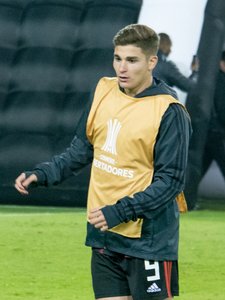In football, a team has 11 players, 1 goalkeeper and 10 other players, consisting of defenders (defenders), midfield (midfielders) and attackers (forwards). used map system Those positions indicate the role and playing area of that position.
At first, there will be only forward positions, halfbacks and thrice quarterbacks. The first period was named like this because It was during the 19th century that the 2–3–5 system was widely popular. The defense will have full-backs known as left-back and right-back. The midfield will have a left-half. Center half and right half And in the offensive line will be outside left, inside left, center striker, inside right and outside right. After that, the format of the system evolved to include many position names. For example, in the early 1970s, the term "half-back" was replaced by the term "midfielder", referring to the position played in midfield both in the middle of the field and on the flanks. The central midfielder has further evolved into an attacking midfielder and a defensive midfielder.
in modern games Positions in football are strictly defined like rugby or American football. Even so, most players tend to play in the same position throughout their careers. Because each position uses different skills and physical abilities. But there are some footballers who can play in multiple positions. which is called "Useful player"
Historical formations
In 19th century football there was no defensive football. Every match is only an attack on each other.
On November 30, 1872, the first national friendly football match was played. between Scotland and England, with the England national team playing in a 7 or 8 forward formation in a 1–1–8 or 1–2–7 formation, while Scotland playing in a 2–2–6 formation. 1 person picks up the broken ball, 1 or 2 people run in midfield and pass the ball forward. The British style of play uses only the personal abilities of the players. which has players with good dribbling skills Players will only make long balls forward as much as they can. or open to other players chasing the ball Scotland used pairs of passes between players, but in the end, despite how much of a striker was used, The game ended in a 0–0 draw.
The original game plan has 7 variations:
1.Pyramid (2–3–5)
2.Metodo (2–3–2–3)
3.WM
4.WW
5.3–3–4
6.4–2–4
7.1–6–3
- Pyramid (2–3–5)
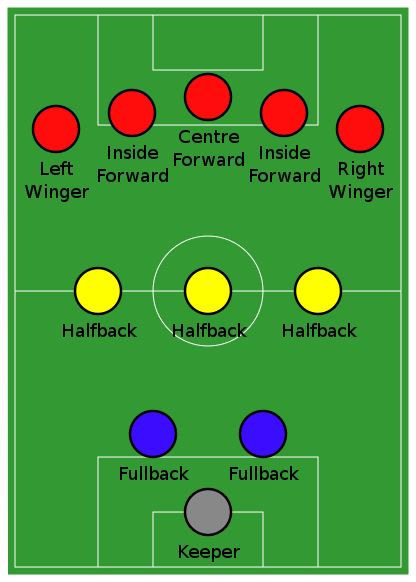
Pyramid formation (2-3-5)
The first long-term successful formation was first recorded in 1880. In Association Football, however, published by Caxton in 1960, the following appears in Vol II, page 432: "Wrexham ... the first winner of the Welsh Cup in 1877 ... for the first time certainly in Wales and probably in Britain, a team played three half-backs and five forwards
The 2–3–5 was originally known as the "Pyramid", with the numerical formation being referenced retrospectively. By the 1890s, it was the standard formation in England and had spread all over the world. With some variations, it was used by most top-level teams up to the 1930s.
For the first time, a balance between attacking and defending was reached. When defending, the two defenders (full-backs) would zonally mark the opponent forwards (mainly the central trio), while the midfielders (halfbacks) would fill the gaps (usually marking the opposing wingers or inside forwards).
The centre halfback had a key role in both helping to organise the team's attack and marking the opponent's centre forward, supposedly one of their most dangerous players.
This formation was used by the Uruguay national team to win the 1924 and 1928 Olympic Games and also the 1930 FIFA World Cup.
It was this formation which gave rise to the convention of shirt numbers increasing from the back and the right.
- Metodo (2–3–2–3)
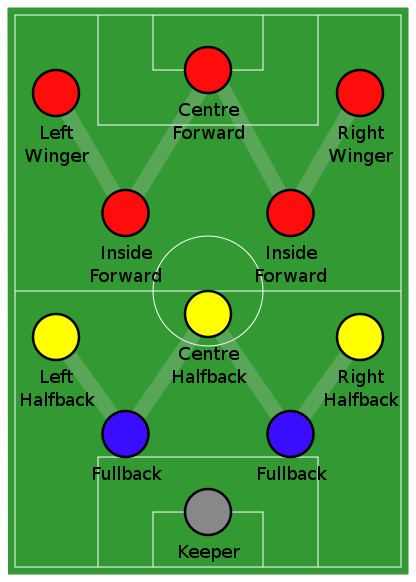
Metodo formation (2-3-2-3)
Danubian school
The Danubian school of football is a modification of the 2–3–5 formation in which the centre forward plays in a more withdrawn position. As played by Austrian, Czechoslovak and Hungarian teams in the 1920s, it was taken to its peak by the Austrians in the 1930s. It relied on short passing and individual skills. This school was heavily influenced by the likes of Hugo Meisl and Jimmy Hogan, the English coach who visited Austria at the time.Metodo (2–3–2–3)
The Metodo formation
The metodo was devised by Vittorio Pozzo, coach of the Italy national team in the 1930s.[4] It was a derivation of the Danubian school. The system was based on the 2–3–5 formation; Pozzo realised that his half-backs would need some more support in order to be superior to the opponents' midfield, so he pulled two of the forwards to just in front of midfield, creating a 2–3–2–3 formation. This created a stronger defence than previous systems, as well as allowing effective counter-attacks. The Italian national team won back-to-back World Cups, in 1934 and 1938, using this system. It has been argued that Pep Guardiola's Barcelona and Bayern Munich used a modern version of this formation.[5] This formation is also similar to the standard in table football, featuring two defenders, five midfielders and three strikers (which cannot be altered as the "players" are mounted on axles). It can be called MM (if the goalkeeper is at the top of the diagram) or WW (if the goalkeeper is at the bottom). - WM
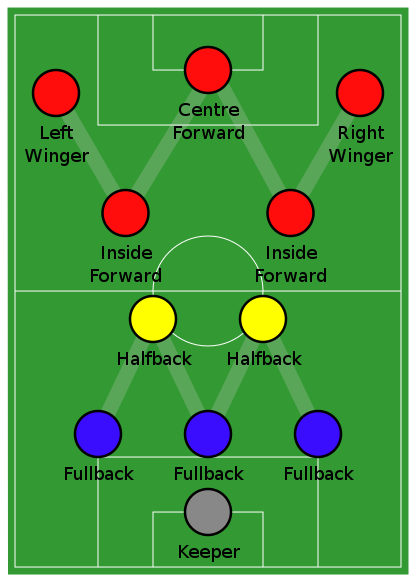
WM Formation
The WM formation, named after the letters resembled by the positions of the players on its diagram, was created in the mid-1920s by Herbert Chapman of Arsenal to counter a change in the offside law in 1925. The change had reduced the number of opposition players that attackers needed between themselves and the goal-line from three to two. This led to the introduction of a centre-back to stop the opposing centre-forward, and tried to balance defensive and offensive playing. The formation became so successful that by the late 1930s most English clubs had adopted the WM. Retrospectively, the WM has either been described as a 3–2–5 or as a 3–4–3, or more precisely a 3–2–2–3, reflecting the letters which symbolise it. The gap in the centre of the formation between the two wing halves and the two inside forwards allowed Arsenal to counter-attack effectively. The WM was subsequently adapted by several English sides, but none could apply it in quite the same way Chapman had. This was mainly due to the comparative rarity of players like Alex James in the English game. He was one of the earliest playmakers in the history of the game, and the hub around which Chapman's Arsenal revolved. In 2016, new manager Patrick Vieira, a former Arsenal player, brought the WM formation to New York City FC. In Italian football, the WM formation was known as the sistema, and its use in Italy later led to the development of the catenaccio formation. The WM formation was used by West Germany during the 1954 FIFA World Cup.[8] It antedates Pozzo's Metodo and made more radical changes to the widely used system of that era: the 2-3-5 formation. -
WW

WW Formation
The WW formation (also known as the MM formation, according to current formation diagram convention – goal keeper at the bottom, similar to MM. But It is called WW formation if the goalkeeper is depicted at the top in the formation diagram as it was customary), was a development on the WM formation. was created by the Hungarian coach Márton Bukovi who turned the WM 3–2–2–3 into a 3–2–3–2 by effectively turning the M forward formation "upside down" (M→W). The lack of an effective centre-forward in his team necessitated moving this player back to midfield to create a playmaker, with a midfielder instructed to focus on defence. This morphed into a 3–2–1–4 formation when attacking, and turned back into 3–2–3–2 when the team lost possession. This formation has been described by some as a kind of genetic link between the WM and the 4–2–4. This formation was successfully used by fellow Hungarian coach Gusztáv Sebes in the Hungary national team (Golden Team) of the early 1950s - 3–3–4
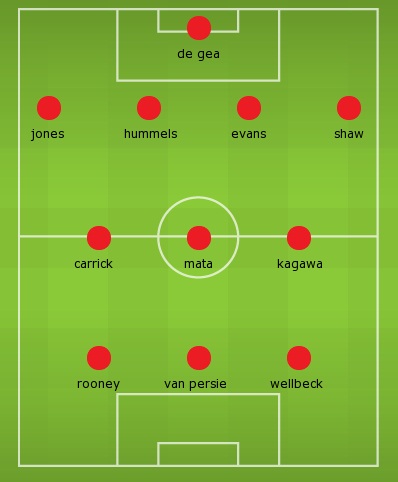
3-3-4 Formation
The 3–3–4 formation was similar to the WW,[citation needed] with the notable exception of having an inside-forward (as opposed to centre-forward) deployed as a midfield schemer alongside the two wing-halves. This formation was commonplace during the 1950s and early 1960s. One of the best exponents of the system was the Tottenham Hotspur's double-winning side of 1961, which deployed a midfield of Danny Blanchflower, John White and Dave Mackay. Porto won the 2005–06 Primeira Liga using this unusual formation under manager Co Adriaanse. - 4–2–4
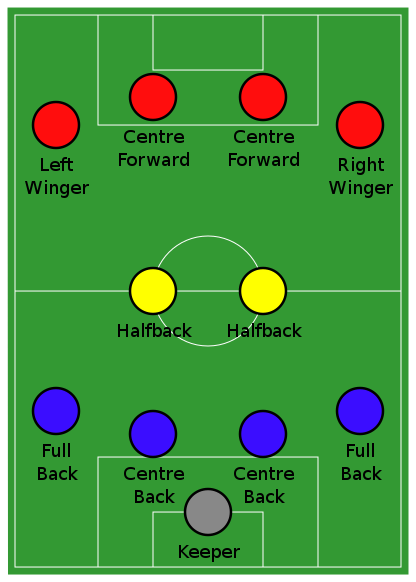
4-2-4 Formation
The 4–2–4 formation attempts to combine a strong attack with a strong defence, and was conceived as a reaction to the WM's stiffness. It could also be considered a further development of the WW. The 4–2–4 was the first formation to be described using numbers.
While the initial developments leading to the 4–2–4 were devised by Márton Bukovi, the credit for creating the 4–2–4 lies with two people: Flávio Costa, the Brazilian national coach in the early 1950s, as well as another Hungarian, Béla Guttman. These tactics seemed to be developed independently, with the Brazilians discussing these ideas while the Hungarians seemed to be putting them into motion. The fully developed 4–2–4 was only "perfected" in Brazil, however, in the late 1950s.
Costa published his ideas, the "diagonal system", in the Brazilian newspaper O Cruzeiro, using schematics and, for the first time, the formation description by numbers. The "diagonal system" was another precursor of the 4–2–4 and was created to spur improvisation in players.
Guttmann himself moved to Brazil later in the 1950s to help develop these tactical ideas using the experience of Hungarian coaches.
The 4–2–4 formation made use of the players' increasing levels of skill and fitness, aiming to effectively use six defenders and six forwards, with the midfielders performing both tasks. The fourth defender increased the number of defensive players but mostly allowed them to be closer together, thus enabling effective cooperation among them, the point being that a stronger defence would allow an even stronger attack.
The relatively empty midfield relied on defenders that should now be able not only to steal the ball, but also hold it, pass it or even run with it and start an attack. So this formation required that all players, including defenders, are somehow skilful and with initiative, making it a perfect fit for the Brazilian players' minds. The 4–2–4 needed a high level of tactical awareness, as having only two midfielders could lead to defensive problems. The system was also fluid enough to allow the formation to change throughout play.
The 4–2–4 was first used with success at the club level in Brazil by Santos, and was used by Brazil in their wins at the 1958 World Cup and 1970 World Cups, both featuring Pelé, and Mário Zagallo, the latter of whom played in 1958 and coached in 1970. The formation was quickly adopted throughout the world after the Brazilian success. Under the management of Jock Stein, Celtic won the 1966–67 European Cup and reached the final of the 1969–70 European Cup using this formation.
It was also used by Vladimír Mirka in Czechoslovakia's victorious 1968 UEFA European Under-18 Championship campaign. He continued to use it after its waning days.
- 1–6–3
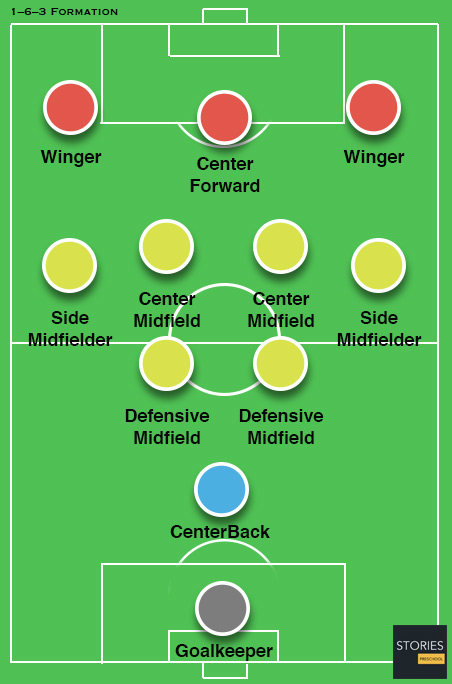
1-6-3 Formation
The 1–6–3 formation was first used by Japan at the behest of General Yoshijirō Umezu in 1936. Famously, Japan defeated the heavily favoured Swedish team 3–2 at the 1936 Olympics with the unorthodox 1–6–3 formation, before going down 0–8 to Italy. The formation was dubbed the "kamikaze" formation sometime in the 1960s when former United States national team player Walter Bahr used it for a limited number of games as coach of the Philadelphia Spartans to garner greater media and fan attention for the struggling franchise.
In conclusion, we will get to know football. One team has 11 players, 1 Goalkeeperand 10 other position players, consisting of defensive players (defenders), Midfielder(midfielders) and attackers (forwards), depending on the map system. use In which those positions will indicate the role and playing area of that position and various plans. Playing football in the past, there were a total of 7 forms. What are these? And in what year and which team was used and invented by whom? I hope that the information I present today will be more or less useful for those who are interested. If those interested in football can find more information in Google Chrome and the Internet.
reference
Formation (association football).several formations of football sport in the past.[Online].Accessible https://en.wikipedia.org/wiki/Formation_(association_football)
Historical formations.several formations of football sport in the past.[Online].Accessible https://en.wikipedia.org/wiki/Formation_(association_football)
original game plan. several formations of football sport in the past.[Online].Accessible https://en.wikipedia.org/wiki/Formation_(association_football)
[youtube: https://www.youtube.com/watch?v=bWcQ0z-Ywos&t=2s]






